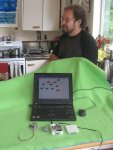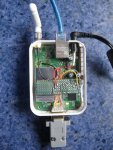Andrew Hornblow has just paid me a visit,& displayed his ~US$30 Accton MR3201A Open Mesh mini-router serial hack. This hack (c/w level shifter fitted onto a trimmed Kiwi Patch Board),readily allows PICAXE style serial feed, perhaps initially sourced via 433 MHz. Signals can then be WiFi handled & ultimately web displayed -Andrew has uploaded diverse happy user pix. Check how dry(Aust/NZ) or frozen(UK/USA) your garden is from a web cafe half a world away!
Open-Mesh now offer a more professional watch dog fitted OM1P (~US$49) as well.
I'm still getting my mind around wireless possibilities the technique offers, but we're looking at rustling things up as an Instructable or SiChip article. "Aha" moments or PICAXABLE applications welcomed- we may even use them as case studies. Any interest ? Stan
Open-Mesh now offer a more professional watch dog fitted OM1P (~US$49) as well.
I'm still getting my mind around wireless possibilities the technique offers, but we're looking at rustling things up as an Instructable or SiChip article. "Aha" moments or PICAXABLE applications welcomed- we may even use them as case studies. Any interest ? Stan
Attachments
-
105.5 KB Views: 85
-
67.1 KB Views: 92
Last edited:


